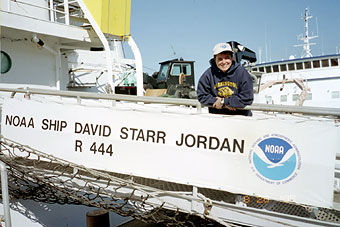

 | |||||||
|
|
Journals 2005/2006Maureen Barrett
August 21, 2005 As a New Jersey teacher, I never expected to find myself on a research vessel in the Pacific Ocean searching for whales, dolphins, and porpoises. But here I am! My name is Maureen Barrett. I teach 8th grade life science at Harrington Middle School in Mt. Laurel, New Jersey. I am aboard the David Starr Jordan, a NOAA scientific research vessel (National Atmospheric and Oceanic Administration). The study is part of NOAA's National Marine Fisheries Service. One of the NOAA projects this year is CSCAPE. CSCAPE is an acronym for Collaborative Survey of Cetacean Abundance in the Pelagic Ecosystem. It is a six-month study made up of seven legs, with each leg being about three weeks long. I am on leg 3. This leg is scheduled to return to land on September 9th. During the next twenty days, we will travel along planned track lines that take us as far out as 300 nautical miles from the coast and from points between Newport, Oregon and San Francisco, California. Thanks to the University of Rhode Island 's ARMADA Project, I am the "teacher at sea." My job is to work with the scientists, learn about how this research is conducted, and help collect data. I look forward to sharing this research experience with my students and colleagues.
The Jordan departed this morning from Newport, Oregon. We headed south, hugging the coastline for about sixty miles before going "on effort." "On effort" is the term used for when we are following the tracklines searching for cetaceans. When a cetacean is sighted, it is up to Chief Scientist Susan Chivers as to whether or not we need to go "off effort" in order to get a closer look at the cetacean/s in order to properly identify the species, get an accurate count, take photographs, and possibly obtain a biopsy. Within the first hour of our journey, we spotted a whale. A big whale! As a matter of fact, the biggest whale - the blue whale (Balaenoptera musculus). Blues are found worldwide, but are most abundant here in the eastern North Pacific. Pacific blue whales usually grow to about 85 feet in length! This whale was immediately identified as a blue whale because of its tall blow, huge size, and very small dorsal fin set far back on its body. When one of the mammal observers spotted the blue whale, she immediately called out its position, stating its angle, reticle (distance), speed, and direction. The chief scientist made the decision to go off effort to get a closer look. As soon as we went off effort, all of the observers on the flying bridge had their "big eyes" out to sea, watching and waiting for another blow. We were fortunate to see about ten blows before it took a deep dive. But before going down, it raised it flukes as if waving goodbye! Again, we watched and waited. About ten minutes later, it resurfaced for air. We watched this behavior for about thirty minutes before getting back on effort. What a great way to start the expedition! By the end of the day, we had recorded one blue whale, one humpback whale, Dall's porpoises, harbor porpoises, and sea lions. We also had an unidentified delphinid (dolphin). |
||||||
